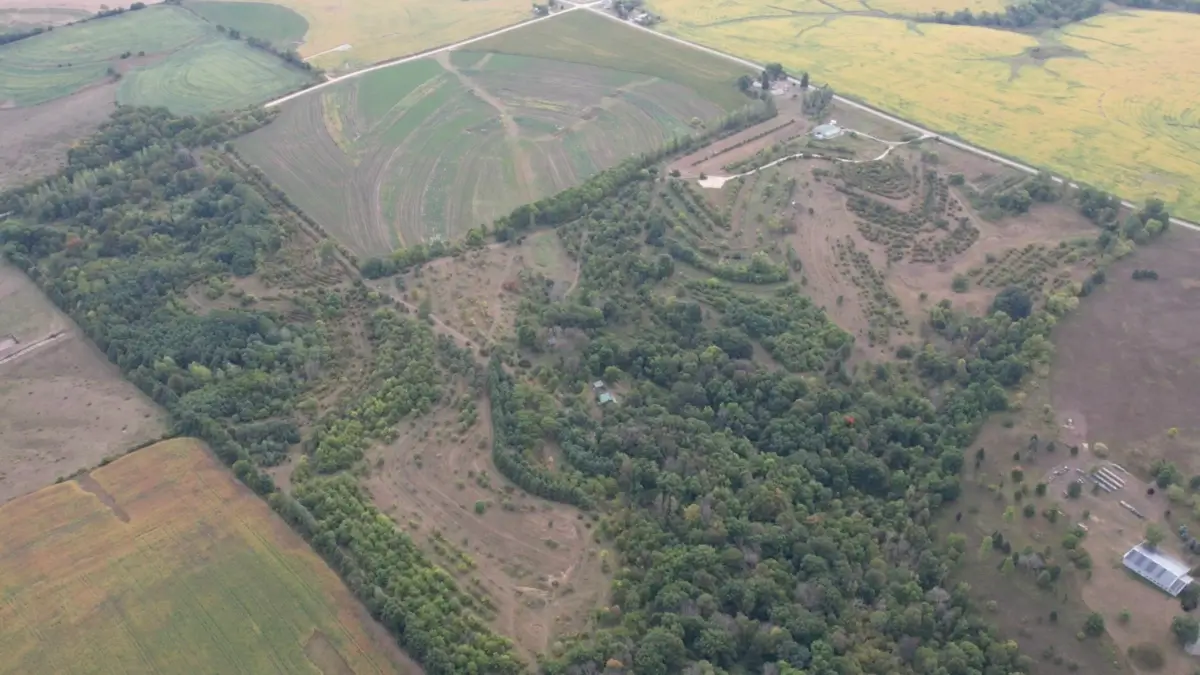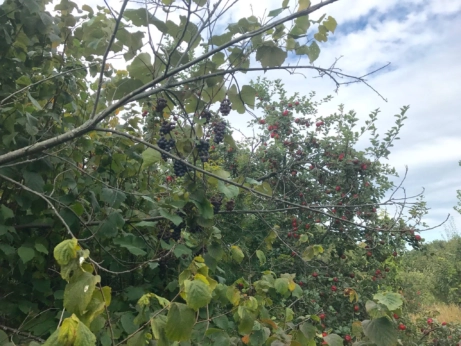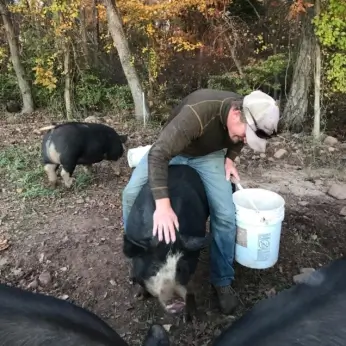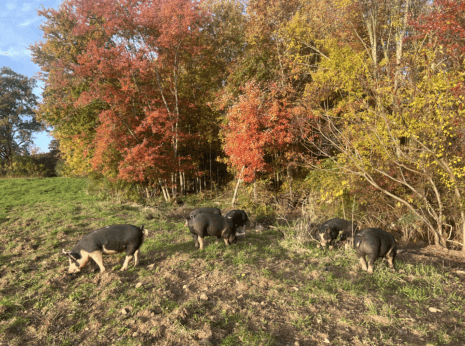Fiddleheads, Not Spinach
Soil erosion and climate change are just some of farming’s most pressing issues. Using familiar (or not-so-familiar) native plants as food crops is one solution.
Fiddleheads, Not Spinach
Soil erosion and climate change are just some of farming’s most pressing issues. Using familiar (or not-so-familiar) native plants as food crops is one solution.

New Forest Farm in the drought, September 2023. Although the pastures were quite brown, they had a full crop of hazelnuts and a decent crop of chestnuts, and never had to feed hay to the cattle.by New Forest Farm
We are crouched on our hands and knees, ripping out lettuce at Andrew’s Farm in Gardiner, Maine, where I work. “Some of them might be slimy,” says the owner, offering me gloves. I’m not squeamish, but he’s right. Many of the plants have rotted at the base, a symptom of a soil fungus brought about by last year’s heavy rainfall and one we are still battling in spite of three greenhouses. As climate change intensifies and our growing season swings from drought to too much rain, harvests become less dependable and more labor intensive to bring to market.
Yet, it’s not the same for all crops, everywhere. Each spring, along a hidden dirt road in northern Maine, my mother squats calve-deep in ditch muck to gather the edible, curled fronds of the ostrich fern, a delicacy that appears year after year regardless of rain, drought or fungus. While small-scale farms increasingly rely upon innovative technology to hedge their bets on a harvestable crop—think Kernza, complicated, mechanical planters or expensive, hybrid seeds—native, perennial crops, like my mother’s fiddleheads, persist regardless of an erratic growing season. This begs the question—what if annual crops can’t offer us the sustainable future we, as farmers and consumers, need?
Finding an old way to farm
Mark Shepard’s New Forest Farm enterprise is built upon what he calls restoration agriculture: growing perennial food crops in a way that mimics native ecological systems. “We need to trust natural plant communities because they’re tried and true. They’ve done alright through just about every disaster that’s been thrown their way,” says Shepard.
Native, perennial plant species—such as fiddleheads—are often better equipped to succeed than non-native, annual plants because they’ve evolved within an ecosystem for millennia. Native plants thrive with fewer or no inputs and, due to genetic diversity, are better equipped to survive in our changing climate. Because of this, landscaping with native species is already widely popular.

Start with small changes
Farmers don’t need to make a whole-sale switch to native species to reap ecological benefits while tapping into an emerging, native-plant market. Small changes, such as converting a single, sub-prime field into a food forest,where a selection of diverse edible plants are grown mimicking the structure of a forest, can be effective. Shepard’s New Forest Farm began with annual crops and transitioned to perennial crops over time.
Native species can also be included in techniques that many sustainability-minded farmers already employ. For example, hedgerows could be planted with species of American hazelnut, with the small, harvested crop offered in community-supported agriculture boxes or at farmer’s markets.
Don Tipping of Siskiyou Seeds offers small quantities of unique crops—some of which are native plants—at farmer’s markets and sells them to customers, who are intrigued by the novel product. Although the success of a product can be hit or miss, as with products at any farmer’s market, sometimes, Tipping’s products sell out, with customers asking for them at the next market. He plans to experiment soon with plant-infused beverages.
In addition, because native plant species support more biodiversity than non-natives, farmers looking to attract beneficial insects for pollination and pest control could plant alley crops of native species that provide food for pollinators and humans, such as sunchokes.
Expand on silvopasture techniques
Much of the shift that farmers must make to incorporate native plants as food crops relies more on mindset than technique. For example, take silvopasture, which is a method of integrating foraging livestock and wooded areas. Farmers such as Kirsten Marra and Chris Wellington of Muddy Roots Farm use silvopasture practices to help feed and shelter livestock. In such a system, oaks and other nut trees are already key. “We know where all our hardwood stands are in the woods, so we choose our ends [of the pasture rotation] to finish the pigs under the nut trees. Tree nuts are high in fat and contribute to nice marbling of the meat; the unsaturated fatty acids help increase flavor and juiciness. They are also a good source of carbohydrates and protein. They’re very good for the animals, and they create a nice fat-cap or fat layer,” says Marra.
In their woodland and field pasture system, the pigs are happier, fatter and healthier, all while eating far less grain—about two buckets a day for 10 pigs—which Marra and Wellington say the pigs don’t touch until yummier foods (including annual vegetable scraps) are gone. But this system also helps the environment. The pigs are rotated frequently to prevent any damage to the land, and their wallowing creates vernal pools, their foot traffic presses seeds into the soil and their munching keeps invasive species in check.
To take a system like this one step further, creative farmers can use trees to produce crops for livestock and people—and not just using acorns or chestnuts. For example, linden tree leaves are great in salads, and their fruit and flowers make a unique (and delicate) chocolate substitute.

A new market
While demand for native plant foods is different from that of annual agricultural crops, a market does exist. Elderberries are particularly trendy, but other native, perennial crops such as sunchokes, pawpaws and even chestnuts are also popular. Still others—such as hazelnuts, ramps and mushrooms—are already in demand at farmer’s markets and by wholesalers alike.
On a national level, websites such as Foraged offer farmers an opportunity to reach a wider audience, with some of the website’s popular crops including boysenberries and American Ginseng.
Using these native, perennial foods instead of annual crops often amounts to a simple substitution, such as frying fiddleheads instead of asparagus, using mashed sunchokes instead of mashed potatoes or using pawpaws in place of bananas in bread.

Long term changes
Changes in our food system must come at the policy level, but some of these changes are happening already. The United States Department of Agriculture (USDA) now recognizes the importance of agroforestry techniques by offering agroforestry grants and funding. More recently, the US Office of Global Food Security released its Vision for Adapted Crops and Soils, which advocates for returning to more traditional crops that grow better in certain climates.
Douglas Tallamy, author of Bringing Nature Home and other books, worries that farmers will over-spray native plant crops and thus mitigate any environmental benefits. But if we work to change consumers’ expectations for Instagrammable, blemish-free food and restore our environments with healthy, resilient plants, we can find a balance between harvest and hope for the future of agriculture.
This isn’t a utopian dream. Consumers’ increased interest in hyper-local foods and regenerative, sustainable agriculture offers support for new ways of farming. Plus, changes in perspective can occur on a crop-by-crop basis as innovative farmers showcase unconventional, native plant foods, even if those foods aren’t staple, dinner-table commodities right now. A great example of crop success is kale, which was once a mere garnish but is now a popular superfood.
With agriculture facing more climate pressure, tenuous land access and fewer resources than ever before, now is the time to make small or farm-wide changes toward planting native, perennial species as crops, even if the path forward seems untraditional or unusual.
Says Chris Wellington of Muddy Roots farm, “They called us crazy for wanting to raise pigs in the woods.”
Follow us
This work is licensed under a Creative Commons Attribution-NoDerivatives 4.0 International License.
Want to republish a Modern Farmer story?
We are happy for Modern Farmer stories to be shared, and encourage you to republish our articles for your audience. When doing so, we ask that you follow these guidelines:
Please credit us and our writers
For the author byline, please use “Author Name, Modern Farmer.” At the top of our stories, if on the web, please include this text and link: “This story was originally published by Modern Farmer.”
Please make sure to include a link back to either our home page or the article URL.
At the bottom of the story, please include the following text:
“Modern Farmer is a nonprofit initiative dedicated to raising awareness and catalyzing action at the intersection of food, agriculture, and society. Read more at <link>Modern Farmer</link>.”
Use our widget
We’d like to be able to track our stories, so we ask that if you republish our content, you do so using our widget (located on the left hand side of the article). The HTML code has a built-in tracker that tells us the data and domain where the story was published, as well as view counts.
Check the image requirements
It’s your responsibility to confirm you're licensed to republish images in our articles. Some images, such as those from commercial providers, don't allow their images to be republished without permission or payment. Copyright terms are generally listed in the image caption and attribution. You are welcome to omit our images or substitute with your own. Charts and interactive graphics follow the same rules.
Don’t change too much. Or, ask us first.
Articles must be republished in their entirety. It’s okay to change references to time (“today” to “yesterday”) or location (“Iowa City, IA” to “here”). But please keep everything else the same.
If you feel strongly that a more material edit needs to be made, get in touch with us at [email protected]. We’re happy to discuss it with the original author, but we must have prior approval for changes before publication.
Special cases
Extracts. You may run the first few lines or paragraphs of the article and then say: “Read the full article at Modern Farmer” with a link back to the original article.
Quotes. You may quote authors provided you include a link back to the article URL.
Translations. These require writer approval. To inquire about translation of a Modern Farmer article, contact us at [email protected]
Signed consent / copyright release forms. These are not required, provided you are following these guidelines.
Print. Articles can be republished in print under these same rules, with the exception that you do not need to include the links.
Tag us
When sharing the story on social media, please tag us using the following: - Twitter (@ModFarm) - Facebook (@ModernFarmerMedia) - Instagram (@modfarm)
Use our content respectfully
Modern Farmer is a nonprofit and as such we share our content for free and in good faith in order to reach new audiences. Respectfully,
No selling ads against our stories. It’s okay to put our stories on pages with ads.
Don’t republish our material wholesale, or automatically; you need to select stories to be republished individually.
You have no rights to sell, license, syndicate, or otherwise represent yourself as the authorized owner of our material to any third parties. This means that you cannot actively publish or submit our work for syndication to third party platforms or apps like Apple News or Google News. We understand that publishers cannot fully control when certain third parties automatically summarize or crawl content from publishers’ own sites.
Keep in touch
We want to hear from you if you love Modern Farmer content, have a collaboration idea, or anything else to share. As a nonprofit outlet, we work in service of our community and are always open to comments, feedback, and ideas. Contact us at [email protected].by Darcy Duda, Modern Farmer
May 17, 2024
Modern Farmer Weekly
Solutions Hub
Innovations, ideas and inspiration. Actionable solutions for a resilient food system.
ExploreExplore other topics
Share With Us
We want to hear from Modern Farmer readers who have thoughtful commentary, actionable solutions, or helpful ideas to share.
SubmitNecessary cookies are absolutely essential for the website to function properly. This category only includes cookies that ensures basic functionalities and security features of the website. These cookies do not store any personal information.
Any cookies that may not be particularly necessary for the website to function and are used specifically to collect user personal data via analytics, ads, other embedded contents are termed as non-necessary cookies.
I ate a lot of fiddleheads years ago, in Alaska and in high eastern Arizona. Mostly boiled or steamed. Unfortunately, those dietary days are in the past. Fiddleheads are now know to be carcinogenic. AND, they have long been known to be cyanogenic [producers of cyanide] when eaten raw. Even a couple of heads can really mess with you. Fortunately, cows, who are not the brightest of range critters in my experience, are not known to boil or steam their forage, so the ferns have had no selective incentive to find a workaround for that. So, that leaves only the… Read more »